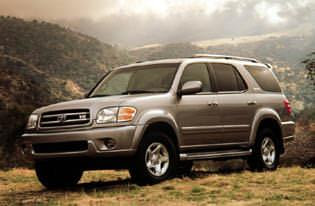 These days, Wall Street's industry analysts love to talk about how the Japanese are threatening America's last bastion of automotive dominance: trucks. But as the following comparison of one of the best American sport utility vehicles and one of the best from Japan indicates, the threat is still a distant one (the government considers SUVs "light trucks").
These days, Wall Street's industry analysts love to talk about how the Japanese are threatening America's last bastion of automotive dominance: trucks. But as the following comparison of one of the best American sport utility vehicles and one of the best from Japan indicates, the threat is still a distant one (the government considers SUVs "light trucks"). Toyota Motor's Sequoia SUV is longer than DaimlerChrysler's Dodge Durango. The Sequoia seats one more passenger than the Durango (eight versus seven) and has the Toyota badge on it, which means an excellent reputation for quality and reliability. Yet in 2004, the Durango outsold the Sequoia in the United States by a ratio of nearly 2.5-to-1.
Toyota's vehicles--with a few exceptions such as its Echo compact--are among the most competitive in the auto business, and in several cases outsell their American competitors. One need not look too hard, however, to see why the cheaper and more powerful Durango is cleaning house in the showrooms.
 For one thing, its volume is increasing because it is, in effect, a hot new player in the full-size SUV game. The Durango used to be more of a midsize SUV, but the vehicle bulked up to 201 inches of overall length after a 2004 overhaul and entered the 204-inch Sequoia's ken.
For one thing, its volume is increasing because it is, in effect, a hot new player in the full-size SUV game. The Durango used to be more of a midsize SUV, but the vehicle bulked up to 201 inches of overall length after a 2004 overhaul and entered the 204-inch Sequoia's ken. With added competition from Nissan Motor's new, full-size Armada SUV--whose named was changed from Pathfinder Armada to avoid confusion with Nissan's Pathfinder SUV--the Sequoia is beginning to look old. Its styling isn't great, and, unlike those of the Durango, its buyers can't answer contemporary advertising by saying, "This thing does indeed have a HEMI."
Daimler has had surprising success at resuscitating HEMI, the brand name its Chrysler Group (including Dodge) uses on certain large, high-horsepower engines. According to a statement released in December, Chrysler Group has sold more than 469,000 vehicles with a HEMI inside since introducing its 5.7-liter HEMI V-8 engine for the 2003 model year. In Chrysler Group vehicles where HEMI is offered, the take-rate is 46%. In addition to its optional, 335-hp HEMI V-8, the Durango offers an interior that is comparatively upscale for a Detroit car, and is one of the best examples of Detroit's forte: truck building.
General Motors Ford Motor and Chrysler still build attractive, powerful trucks. Nissan is encroaching on traditional Detroit territory with increasingly big truck engines, and Toyota's next generation full-size pickup--the replacement for the Tundra--will be more on the money in terms of styling.
But America's seeming embrace of domestic truck styling is a mitigating factor in the success of vehicles such as the Durango. The handsome looks of Ford's F-Series pickups help make them the country's best-selling vehicles; after all, the F-Series' competitors offer comparable engines, body styles and varieties of configurations, and have similarly less-than-perfect reputations for reliability.
American truck makers also have more dealers here than the Japanese, and a different audience. The Durango and Sequoia are body-on-frame trucks--vehicles in which the body structures are attached to separate frames, as opposed to the combined body-and-chassis structures of "unitized" cars--and buyers of such vehicles have traditionally tended to be blue collar and, in many cases, distrusting of import brands.
Of course, Toyota's reputation is sterling, and even traditional American truck buyers can't deny the Sequoia. It has 282 hp and a well-designed, roomy interior. It is sold by dealers who don't have a reputation for being particularly friendly, but offer extremely high-quality cars.
However, the Durango also has a geographic advantage over the Sequoia. The popularity and reputation of Japanese cars stems from America's coasts and branches out to the country's middle. But trucks are more popular in the heartland, in places such as the Deep South, the Sun Belt and the Midwest, where far more trucks exist per capita than on the coasts. Trucks are thus something of a red-state phenomenon, something that plays more into the hands of the Midwest-based American automakers than the blue-state-oriented Japanese.
Wall Street analysts recognize a significant threat to domestic automakers. The Japanese are on the way to America with more and bigger trucks--not to mention more and more North American production thereof. Please see the slide show for a closer look at the battle between two of the best light trucks out there.
from here